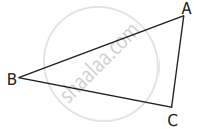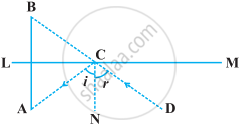Advertisements
Advertisements
प्रश्न
If each angle of a triangle is less than the sum of the other two, show that the triangle is acute angled.
उत्तर
Given each angle of a triangle less than the sum of the other two
`∴∠A+∠ B+∠C`
`⇒∠A+∠A<∠A+∠B+∠C`
`⇒2∠A<180^@`
[Sum of all angles of a triangle]
`⇒∠A<90^@`
Similarly` ∠ B< 90^@ and ∠C<90^@`
Hence, the triangles acute angled.
APPEARS IN
संबंधित प्रश्न
In ΔABC, if bisectors of ∠ABC and ∠ACB intersect at O at angle of 120°, then find the measure of ∠A.
In ΔPQR, If ∠R > ∠Q then ______.
State, if the triangle is possible with the following angles :
20°, 70°, and 90°
State, if the triangle is possible with the following angles :
60°, 60°, and 50°
Can a triangle together have the following angles?
85°, 95° and 22°
Find x, if the angles of a triangle is:
x°, x°, x°
Can you draw a triangle with 25°, 65° and 80° as angles?
In ΔABC, name the 
a) Three sides: _________, __________, __________
b) Three Angles: _________, __________, __________
c) Three Vertices: _________, __________, __________
The image of an object placed at a point A before a plane mirror LM is seen at the point B by an observer at D as shown in the following figure. Prove that the image is as far behind the mirror as the object is in front of the mirror.
[Hint: CN is normal to the mirror. Also, angle of incidence = angle of reflection].

Can we have two acute angles whose sum is an acute angle? Why or why not?
